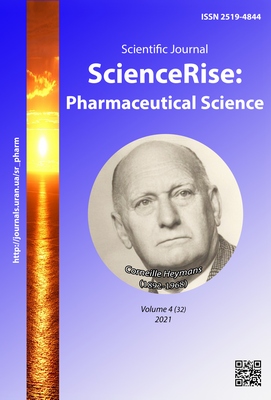Peculiarities of disorders of nitrogen oxide system in the blood at adrenalin-induced myocardial injury in conditions of immobilization stress and their correction by L-arginine
DOI:
https://doi.org/10.15587/2519-4852.2021.238320Keywords:
Free arginine, nitric oxide system indicators, adrenaline-induced myocardial injury, immobilization stressAbstract
The aim: of the study was to elucidate the changes to nitric oxide activity in the blood during adrenaline-induced myocardial injury under immobilization stress and to establish the corrective effect of L-arginine.
Methods: determination of free arginine was conducted by the method of Aleinikova T.L., total nitric oxide products in the blood by the method of Schmidt H.H., the total activity of nitric oxide synthase by the method of Sumbaiev V.V.. Immobilization stress was reproduced by the method of Horizontov P.D. Adrenaline-induced myocardial injury was reproduced by the method of Markova O.O. L-arginine was injected based on scientific data by Kiryanova N.A.
Results. Studies have shown that on days 1 and 3 with adrenaline-induced myocardial injury under immobilization stress there was an increase in nitric oxide products in the blood, respectively, according to control. The use of L-arginine on the 5th day, led to a decrease in levels of NO products in the blood by less than, lower against the group of animals with MI and IS, to treatment.
Conclusions. Thus, biochemical studies of NO system in the dynamics of IS and MI showed an increase in food content and total synthase activity of NO on the background of reduced levels of L-arginine, which were detected at all stages of the study and especially expressed on the 1st day before treatment. The use of the drug L-arginine, made it possible to identify its corrective effect on impaired metabolic processes in MI and IS
References
- Mortidelli, L., Bonavida, B. (Eds.) (2019). Therapeutic application of Nitric Oxide in Cancer and Inflammatory Disorders. Elsilver Academic Press, 113–123. doi: http://doi.org/10.1016/c2018-0-00832-4
- Nicolaides, N. C., Kyratzi, E., Lamprokostopoulou, A., Chrousos, G. P., Charmandari, E. (2015). Stress, the Stress System and the Role of Glucocorticoids. Neuroimmunomodulation, 22 (1-2), 6–19. doi: http://doi.org/10.1159/000362736
- Spiers, J. G., Chen, H.-J. C., Sernia, C., Lavidis, N. A. (2015). Activation of the hypothalamic-pituitary-adrenal stress axis induces cellular oxidative stress. Frontiers in Neuroscience, 8. doi: http://doi.org/10.3389/fnins.2014.00456
- Malakhov, V. O, Monastirskiy, V. O. (2010). Sovremennie idei pro imunno-neyroendokrinoy sistemi v normi i pri patologii. Kniga spetsialista, 11-12, 331–332.
- Levy, B. H., Tasker, J. G. (2012). Synaptic regulation of the hypothalamic–pituitary–adrenal axis and its modulation by glucocorticoids and stress. Frontiers in Cellular Neuroscience, 6. doi: http://doi.org/10.3389/fncel.2012.00024
- Coletta, C., Papapetropoulos, A., Erdelyi, K., Olah, G., Modis, K., Panopoulos, P. et. al. (2012). Hydrogen sulfide and nitric oxide are mutually dependent in the regulation of angiogenesis and endothelium-dependent vasorelaxation. Proceedings of the National Academy of Sciences, 109 (23), 9161–9166. doi: http://doi.org/10.1073/pnas.1202916109
- Martínez-Ruiz, A., Cadenas, S., Lamas, S. (2011). Nitric oxide signaling: Classical, less classical, and nonclassical mechanisms. Free Radical Biology and Medicine, 51 (1), 17–29. doi: http://doi.org/10.1016/j.freeradbiomed.2011.04.010
- Leo, C. H., Jelinic, M., Ng, H. H., Marshall, S. A., Novak, J., Tare, M. et. al. (2016). Vascular actions of relaxin: nitric oxide and beyond. British Journal of Pharmacology, 174 (10), 1002–1014. doi: http://doi.org/10.1111/bph.13614
- Lundberg, J. O., Gladwin, M. T., Weitzberg, E. (2015). Strategies to increase nitric oxide signalling in cardiovascular disease. Nature Reviews Drug Discovery, 14 (9), 623–641. doi: http://doi.org/10.1038/nrd4623
- Napoli, C., Ignarro, L. J. (2009). Nitric oxide and pathogenic mechanisms involved in the development of vascular diseases. Archives of Pharmacal Research, 32 (8), 1103–1108. doi: http://doi.org/10.1007/s12272-009-1801-1
- Kiriianova, N. A. (2006). Neirotropni ta imunotropni efekty of L-arhininu, 133.
- Khavrona, O. P. (2014). Influence of the dual COX-2/5-LOG inhibitor on the activity of L-arhinin/NO system in rat's blood with experimental ulcer of the stomach. Bukovinian Medical Herald, 2, 249–251.
- Gorіzontov, P. D., Belousova, O. I., Fedorov, M. I. (1983). Stress i sistema krovi. Moscow: Meditsina, 338.
- Markova, O. O. (1998). Myokardialna dystrofiia ta reaktyvnist orhanizmu. Ternopil: Ukrmedknyha, 152.
- Aleynikova, T. L., Rubtsova, H. V., Pavlova, N. A. (2000). Rukovodstvo po prakticheskim zanyatiyam po Biokhimii. Moscow: Meditsina, 128.
- Schmidt, H. H. H. W., Hofmann, H., Schindler, U., Shutenko, Z. S., Cunningham, D. D., Feelisch, M. (1996). No {middle dot}NO from NO synthase. Proceedings of the National Academy of Sciences, 93 (25), 14492–14497. doi: http://doi.org/10.1073/pnas.93.25.14492
- Simpaev, V. V., YAsinskaya, I. M. (2000). Vliyanie DDT na aktivnost nitrit oksid sintazy u pecheni, legkikh ta golovnom mozge u krys. Sovremennye problemy Toksikologi, 3, 3–7.
- Tkach, E. I., Storozhuk, V. P. (2009). Zahalna teoriia statystyky. Kyiv: Tsentr uchbovoi literatury, 440.
- Forstermann, U., Sessa, W. C. (2011). Nitric oxide synthases: regulation and function. European Heart Journal, 33 (7), 829–837. doi: http://doi.org/10.1093/eurheartj/ehr304
- Habib, S., Ali, A. (2011). Biochemistry of Nitric Oxide. Indian Journal of Clinical Biochemistry, 26 (1), 3–17. doi: http://doi.org/10.1007/s12291-011-0108-4
Downloads
Published
How to Cite
Issue
Section
License
Copyright (c) 2021 Oksana Lys, Mykhailo Reheda, Nataliya Sementsiv, Mariana Reheda-Furdychko, Stepan Reheda

This work is licensed under a Creative Commons Attribution 4.0 International License.
Our journal abides by the Creative Commons CC BY copyright rights and permissions for open access journals.








